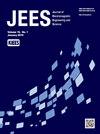Analysis Method for Determining Optimal Synthetic Aperture Time Using Estimated Range and Doppler Cone Angle at the Center of Synthetic Aperture Length
IF 1.7
3区 工程技术
Q3 ENGINEERING, ELECTRICAL & ELECTRONIC
Journal of electromagnetic engineering and science
Pub Date : 2023-05-31
DOI:10.26866/jees.2023.3.r.160
引用次数: 0
Abstract
Synthetic aperture time (SAT) is a crucial component for acquiring high-quality synthetic aperture radar images with an excellent target cross-range resolution. SAT is analyzed using the range and Doppler cone angle at the center of the synthetic aperture length (SAL). However, in a real flight mission setting, only the range and Doppler cone angle at the SAL’s starting point are determined. Therefore, we present a method for estimating the range and Doppler cone angle at the center of the SAL to calculate an accurate SAT that is suitable for the spatial resolution of the assigned mission. We performed an iterative analysis of SAT at the range and Doppler cone angle at the starting point of the SAL (original SAT) and at the center of the SAL (proposed SAT). Consequently, the proposed SAT decreased by 0.69%–16.14% compared to the original SAT at a resolution of 0.1–3.0 m.利用估计距离和合成孔径长度中心的多普勒锥角确定最佳合成孔径时间的分析方法
合成孔径时间(SAT)是获取高质量合成孔径雷达图像的关键组成部分,具有优异的目标跨程分辨率。使用合成孔径长度(SAL)中心的距离和多普勒锥角来分析SAT。然而,在实际飞行任务设置中,只有SAL起点处的距离和多普勒锥角是确定的。因此,我们提出了一种估计SAL中心的距离和多普勒锥角的方法,以计算适合指定任务空间分辨率的精确SAT。我们在SAL(原始SAT)起点和SAL(拟议SAT)中心的距离和多普勒锥角处对SAT进行了迭代分析。因此,与分辨率为0.1–3.0 m的原始SAT相比,拟议SAT降低了0.69%–16.14%。
本文章由计算机程序翻译,如有差异,请以英文原文为准。
求助全文
约1分钟内获得全文
求助全文
来源期刊

Journal of electromagnetic engineering and science
ENGINEERING, ELECTRICAL & ELECTRONIC-
CiteScore
2.90
自引率
17.40%
发文量
82
审稿时长
10 weeks
期刊介绍:
The Journal of Electromagnetic Engineering and Science (JEES) is an official English-language journal of the Korean Institute of Electromagnetic and Science (KIEES). This journal was launched in 2001 and has been published quarterly since 2003. It is currently registered with the National Research Foundation of Korea and also indexed in Scopus, CrossRef and EBSCO, DOI/Crossref, Google Scholar and Web of Science Core Collection as Emerging Sources Citation Index(ESCI) Journal. The objective of JEES is to publish academic as well as industrial research results and discoveries in electromagnetic engineering and science. The particular scope of the journal includes electromagnetic field theory and its applications: High frequency components, circuits, and systems, Antennas, smart phones, and radars, Electromagnetic wave environments, Relevant industrial developments.
 求助内容:
求助内容: 应助结果提醒方式:
应助结果提醒方式:


